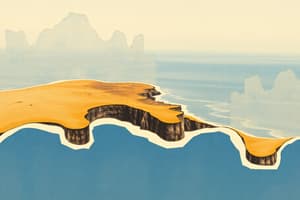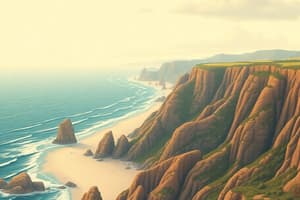Podcast
Questions and Answers
A coastline only includes beaches and cliffs, excluding other features like bays and estuaries.
A coastline only includes beaches and cliffs, excluding other features like bays and estuaries.
False (B)
A tombolo is a ridge of sand joining an island to the shoreline.
A tombolo is a ridge of sand joining an island to the shoreline.
True (A)
Coastlines primarily composed of sandstone tend to erode slower than coastlines made of granite.
Coastlines primarily composed of sandstone tend to erode slower than coastlines made of granite.
False (B)
Areas with a small tidal range typically have waves that deposit material further inland compared to areas with a large tidal range.
Areas with a small tidal range typically have waves that deposit material further inland compared to areas with a large tidal range.
Coastal plains are elevated, hilly regions that are resistant to flooding.
Coastal plains are elevated, hilly regions that are resistant to flooding.
Flashcards
What is a coastline?
What is a coastline?
The meeting point of land and the seas or oceans, including beaches, cliffs, capes, caves, bays, and estuaries.
What is a stack?
What is a stack?
A needle-shaped column of rock resulting from the collapse of an arch.
What is a spit?
What is a spit?
An elongated ridge of sand or pebbles extending into the water.
What are tides?
What are tides?
Signup and view all the flashcards
What do waves do to the coastline?
What do waves do to the coastline?
Signup and view all the flashcards
Study Notes
- Coastlines mark where land meets seas or oceans
- Coastlines include beaches, cliffs, capes, caves, bays, and estuaries
- Smaller landforms line up along a coast
Coastal Features
- Natural Arch: An arch hollowed out of a headland
- Rocky Islet: A small island made of rock
- Skerry: A rock tip just above the water's surface
- Stack: A needle-shaped column from a collapsed arch
- Spit: A ridge of sand or pebbles extending into the water
- Cliff: A steep rock face shaped by the sea
- Sand Island: An exposed summit of a sand deposit near or far from a shoreline
- Headland: A tapering strip of land jutting into the sea
- Tombolo: A ridge of sand joining an island to the shoreline
- Beach: An accumulation of sand or pebbles along a coast
- Dune: An accumulation of sand shaped by the wind
- River Estuary: A river's mouth, influenced by tides, forming a coastline indentation
- Cave: A natural underground cavity from the slow dissolution/erosion of rock by water
- Lagoon: A shallow seawater expanse separated by sand or a barrier island
Changing Coastlines
- Waves, tides, and currents create coastlines
- Coastal changes take hundreds of years to occur
- Harder materials in the land mean that the coastline is harder to erode
- Coastlines of a hard rock like granite are very stable over long periods of time
- Tides deposit sediment and other objects on the coast
- Large tidal ranges result in waves depositing material farther inland
- Small tidal ranges result in waves leaving material closer to shore
- Larger waves carry more energy and move more sediment/rock
Beaches
- Coastlines with big beaches provide more space for waves to spread energy and deposits
- Coastlines with small, narrow beaches have less room for waves to spread
- Narrow beaches have a tattered, weathered appearance as the waves' energy is focused in a small place
- Sandy beaches are easily washed away
- Rocky coastlines are often cracked by strong waves
Natural Events and Pollution
- Coasts help understanding of weather and changing sea levels
- Coasts are the first places to flood during storms
- Coastal plains are flat, low-lying land that can become visible when sea levels decrease
- Pollution, oil spills, and garbage negatively affect coasts, damaging marine life
Studying That Suits You
Use AI to generate personalized quizzes and flashcards to suit your learning preferences.




